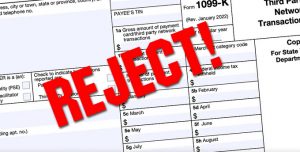
So, in January 2021, a ton of boxes fell on me in my garage. Humorously, I’m already sounding like a cliché. Please forgive me!
Seriously, though, I wasn’t injured, but it was a wake-up call that my family and I needed to clean up the cluttered mess that had been accumulating in the garage over the years. It was like a hoarder’s paradise in there, and we needed to do something about it.
As we started organizing and going through all the stuff, we realized that we had a goldmine of collectibles just sitting there, gathering dust. How did we forget about this treasure trove? It was like finding a hidden gem in our own backyard.
So, we decided to sell everything on eBay, and to our surprise, we made enough money to completely redo our kitchen and still have some cash to spare. It was like hitting the jackpot without even trying.
But just as we were basking in our good fortune in 2021, the IRS decided to rain on our parade, as well as many others, by lowering the reporting ceiling for small business owners and gig workers, including the most beloved of all the online merchants: eBay sellers. The original limit of $20,000 had been reduced to a measly $600. It felt like a punch in the gut, especially for those who rely on their small businesses to make ends meet, like a military veteran I know who uses his eBay shop to pay for medical expenses.
I don’t mean to rant, but for us “commoners” who own small businesses, that’s our livelihood. While the IRS did give us a temporary break, we know that tax time will come a-knocking in 2024. All of us entrepreneurs and small business owners need to make our voices heard!
The argument:
Back in 2021, the IRS lowered the reported ceiling for the 1099-K form from $20,000 to a measly $600. That’s right, folks. If you process more than $600 through a payment processor like PayPal or Square, you’ll receive a 1099-K form in the mail. Let’s take a closer look at why this is a problem.
First of all, the 1099-K is just downright confusing, to say the least. This form doesn’t differentiate between refunds, chargebacks, or fees that the payment processor may have taken out of a transaction. This means that small business owners may still end up owing taxes on money that they never actually received. I’ve personally seen this in a lot of the sales that I made off of eBay. Furthermore, with the lowered ceiling of $600, even more, small business owners like myself will be affected.
Secondly, even if a business owner processes $601 through a payment processor, they will receive a 1099-K form and may end up owing taxes on that small of an amount. This can be especially devastating for businesses that are just starting out and don’t have a lot of revenue acquired yet.
But perhaps the biggest issue with the 1099-K is that it’s a threat to entrepreneurship in this country. Small business owners are the lifeblood of our economy, and yet they’re being strangled by confusing tax forms and unnecessary financial burdens. It’s hard enough to start and maintain a small business, but when you add in the stress of dealing with the IRS in the way of inaccurate tax reporting, it becomes almost impossible and dangerous.
So, what’s the solution? The IRS needs to come up with a better way to track payment transactions that don’t put small business owners at risk. We need a system that accurately reflects the amount of money that business owners are actually earning, not just the amount that was processed through a payment processor. Until that happens, the 1099-K will continue to stifle small businesses and entrepreneurship in this country.
In conclusion, the lowered ceiling for the 1099-K is a serious problem for small business owners and entrepreneurs. Moreover, maybe it’s better to leave the 1099-K the way it was prior to being lowered until it can really be thought through in a way that everybody can agree upon. We need a system that is clear, accurate, and fair. The future of entrepreneurship in this country depends on it.

Hey there, amigos and amigas! I’m Paul, the pajama-wearing article writer who can bring enchantment, charm, and wit to your content. If you’re looking for high-quality content that can skyrocket your conversion rates, increase organic traffic, and establish brand authority, you’ve come to the right place!
I’m not just your ordinary content writing service provider. I’m a guy who knows how to count (well, at least when it comes to the number of pages I can write on Shakespeare) and deliver content that can put your competitors in the spotlight. My writing style is a fusion of tutorials, entertainment, internet marketing, and video games. If that sounds like a bizarre mix, that’s because it is, and that’s precisely what makes it work!
I may have started as an engineering major, but I quickly realized that my true calling was in the world of computers and writing. While my peers struggled to reach the minimum page requirement, I was busy turning in 22-page essays on English literature (cue the eye rolls of my professors). And that was just the beginning.
With my eclectic resume and vast experiences, I’ve learned a thing or two about user engagement, social media shares, and bounce rates. I’ve also owned a successful computer repair business, and I’ve helped Amazon affiliates boost their sales with my content. But above all, writing is my passion and my escape from reality. It’s a way for me to bring enchantment to the mundane and distraction from my health condition (which I won’t bore you with).
So, if you want quality content that can make your readers chuckle, think, and click that “share” button, look no further than yours truly, the pajama-wearing article writer extraordinaire! Who knows, with my help, maybe you’ll be the next big thing in your industry!
May the Force be With You!


